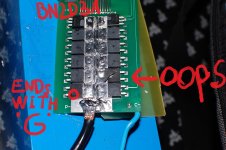Greetings gentlemen.
I hope this is an appropriate place to post my conundrum. I will need to replace a charge FET on my Ping BMS, but the lettering appears to be sanded off, so I am at a loss of what to do.
Situation: User error. Connected batteries in series before disconnecting parallel charger, resulting in a short.
Hardware: 2x
Ping Ver2.5, 36v20Ah in series via Ping provided serial harness. 5A ping BMS, Current limited benchtop power supply 44.95v5.2A
Damage:
- Destroyed XLR plug on one battery (C- pin melted). I replaced the plug already.
- Cracked charge side Mosfet on BMS. See pic below
Diagnostics so far:
- Continuity checks out at all plugs.
- Charger is fine.
- Combined battery pack discharges normally.
-
Batt A discharges and recharges normally.
-
Batt B discharges normally. Each individual cell checks out, combined resting voltage at 39.3v.
-
Batt B- Battery B will not recharge at all.

You can see from the picture that at least two different types of FET is in use on the BMS board. Any ideas about what component I need for the charge FETS?
Thank you for your time - Tom





